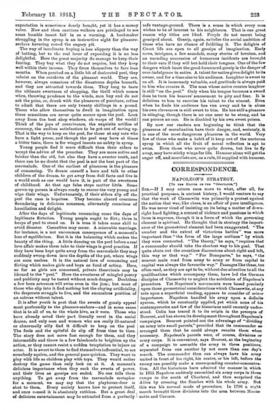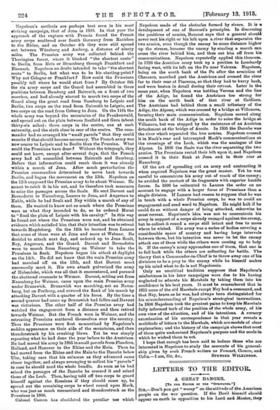CORRESPONDENCE.
NAPOLEON'S STRATEGY.
[To elm EDITaa on sea “Srsounon."] Sra,—If I may return once more to what, after all, for practical purposes, is ancient history, I would venture to say that the work of Claneewitz was primarily a protest against the notion that war, like chess, is an affair of pure intelligence. He was never tired of insisting on its being a matter of down- right hard fighting, a contest of violence and passions in which force is supreme, though it is a force of which the governing element is spiritual. He thought that in strategy the import- ance of the geometrical element had been exaggerated. " The number and the extent of victorious battles" was more important than "the form of the large outlines" by which they were connected. "The theory," he says, "requires that a commander should take the shortest way to his goal. That quite shuts out the countless discussions about right and left, this way or that way." "For Bonaparte," he says, "the nearest main road from army to army or from capital to capital was always the favourite way." Passages like these, too often read, as they are apt to be, without due attention to all the qualifications which accompany them, have led the German disciples of Clasniewitz to neglect the subtleties of Napoleon's procedure. Yet Napoleon's movements were based precisely upon those geometrical considerations which Clausewits, at any rate upon a superficial reading, appears to consider of minor importance. Napoleon handled his army upon a definite system, which he constantly applied, yet which none of bis contemporaries and few of the historians until recently under- stood. Colin has traced it to its origin in the prompts of Bourcet, and has shown its development throughout Napoleon's campaigns. Boureet pointed out the advantage of "dividing an army into small parcels," provided that its commander so
arranged them that be could always reunite them when necessary. Napoleon's parcels were, of course, divisions or army corps. It is convenient, says Bourcet, at the beginning of a campaign to assemble the army in three positions, separated from one another by not more than one day's march. The commander then can always have his army united in front of bis right, his centre, or his left, before the enemy can possibly make a corresponding counter-concentra- tion. All the historians have admired the manner in which in 1815 Napoleon suddenly assembled six army corps in three camps to the south of Charleroi, and then surprised the Allies by crossing the Sambre with his whole army. But this was his normal mode of procedure. In 1796 a night march brought three divisions into the area between Monts notte and Careare.
Napoleon's methods are perhaps best seen in his moat striking campaign, that of Jena. in 1806. In that year the approach of the rupture with Prussia found the French army corps scattered over South Germany from Ratisbon to the Rhine, and on October 4th they were still spread out between Wilmburee and Amberg, a distance of ninety miles. The Prussian army was collected behind the Thuringian forest, where it blocked "the shortest route" to Berlin, from Metz or Strassburg through Frankfurt and Eisenach. Napoleon no doubt intended to take "the shortest route" to Berlin, but what was to be his starting-point P Why not Cologne or Frankfurt P How could the Prussians possibly tell where be would start from P By October 8th the six army corps and the Guard bad assembled in three positions between Bamberg and Baireuth, on a front of two marches, and had already started to march two corps of the Guard along the great road from Bamberg to Leipaio and Berlin, two corps on the road from Baireuth to Leipeic, and two corps on the road from Coburg to Jena. On the Ilth the whole army was beyond the mountains of the Frankenwald, and spread out on the plain between Saalfeld and Gera (about thirty-six miles): three corps in the centre, one at each extremity, and the sixth close in rear of the centre. The eons- mender had so arranged his " small parcels " that they could reunite if that should become necessary. The French army was now nearer to Leipsic and to Berlin than the Prussian. What could the Prussians have done P Without the telegraph, they could not know, except after several days, that the French army had all assembled between Baireuth and Bamberg. Before that information could reach them it was already within a march of Jena. After much perturbation the Prussian commanders determined to move back towards Berlin, and began the movement on the 13th. Napoleon on the 12th supposed the Prussian army toles about Weimar. He meant to catch it in his net, and be therefore took measures to seize the passages across the Seale. He sent Devout and Bernadotte to Naumburg, Lemma to Jena, and Angerean to Kahle, while he had Soult and Ney within a march of any of them. He wanted to know not so much where the Prussians were as what they intended to do, so he ordered Murat to " flood the plain of Leipsie with his cavalry." In this way be found out where the Prussians were not, and be obtained evidence which satisfied him that their intention was to retreat towards Magdeburg. On the 13th he learned from Lawns that some of them were at Jena and more at Weimar. He decided to attack next day, and ordered up to Jena Soult, Hey, Angereau, and the Guard. Devout and Bernadotte were to march from Naomburg on Weimar to take the Prussians in flank. Napoleon began his attack at daylight on the 14th. He did not know that the main Prussian army bad marched off on the 13th, and that Devout must necessarily meet it. His own attack pulverized the army of Hohenlohe, which was all that it encountered, and pursued the shattered remnants to Weimar. Devout, setting out from Eaumburg for Weimar. came upon the main Prussian army under Brunswick. Brunswick was marching, not on Harm- burg, but on Freiburg, and covered the Hank of his march by attacking Devout with a quarter of his force. By the time a second quarter had come up Brunswick had fallen andDarout was victorious. The other half of the Prussian army had watched the engagement from a distance and then retired towards Weimar. But the French were in Weimar, and the retreating Prussians scattered themselves over the country. Thus the Prussians were first mesmerized by Napoleon's trodden appearance on their side of the mountains, and then thunderstruck by his crushing blows. Yet he was simply repeating wbat be had done the year before to the Austrians. He had moved his army in 1805 in small parcels from Flanders, Holland, and Hanover to the Rhine and the Main. Then he bad moved from the Rhine and the Main to the Danube below Elm, taking care that his columns as they advanced came closer together, and always arranging to collect his "parcels" in case he should need the whole bundle. As soon as he had seized the passages of the Danube be crossed it and seized those of the Lech. Then, having told off two corps to guard himself against the Russians if they should come up, he spread out the remaining corps to wheel round upon Mack, who was just as much mesmerized and thunderstruck as the Prussians in 1806.
Colonel Camon has elucidated the peculiar use which Napoleon made of the obstacles formed by rivers. It is a development of one of Boureet's principles. In discussing the positions of armies, Boureet says that a general should
never rest his right or his left upon a river that separates the two armies, even though the enemy be some distance higher
up the stream, because the enemy by stealing a march can cross the river behind him, and thus out him off from his communications. Napoleon repeatedly applied this theorem.
In 1796 the Austrian army took up a position in Lombardy facing west, with its left on the Po near Valenta. Napoleon, being on the south bank of the Po after the armistice of Marasco, marched past the Austrians and crossed the river far to their rear at Piacenza, so that they had to hurry back, and were beaten in detail during their retreat. Later in the same year, when Napoleon was holding Verona and the line of the Adige, he found the Austrians too strong for him on the north bank of that river at Coldiero.
The Austrians had behind them a small tributary of the Adige, the Alpone, which was crossed by a bridge at Villanova, forming their main communication. Napoleon moved along the south bank of the Adige in order to seize the bridge at Villanova, but was stopped by the resistance of an Austrian detachment at the bridge of Arcole. In 1805 the rhumba was the river which separated the two armies. Napoleon crossed it in black's rear and intercepted Mack's communications at the crossings of the Lech, which was the analogue of the Alpone. In 1806 the Seale was the river separating the two armies. The Prussians rested their left upon it, and Napoleon crossed it in their flank at Jena and in their rear at Naumburg.
Of the art of spreading out an army and contracting it when required Napoleon was the great master. Yet he was
careful to concentrate his army out of reach of the enemy ;
he avoided the contact of its fragments with superior hostile forces. In 1806 he reiterated to Lemma the order on no
account to engage with a larger force of Prussians than a single division. If Lannes had reason to suppose that be was in touch with a whole Prussian corps, he was to avoid an engagement and send word to Napoleon. He might halt if he could do so without danger of being attacked, otherwise he must retreat. Napoleon's idea was not to concentrate his army in support of a corps already engaged against the enemy, but to collect it round a corps still intact and free to move where he wished. His army was a series of bodies covering a considerable space of country and having large intervals between them, but his intention was never to let the enemy attack one of them while the others were coming up to help it. If the enemy's army approaches one of them, that one is to fall buck while the others are collecting for battle. The theory that a Commander-in-Chief is to throw away one of his divisions to be a prey to the enemy while ho himself makes up his mind what to do is not Napoleonic.
Only an uncritical tradition supposes that Napoleon's misfortunes in his later campaigns were due to his having neglected to educate his Marshals by taking them into his confidence in his best years. It must be remembered that in 1815 none of the old Marshals except Ney had a command, and that Ney, brave as be was, had always been distinguished for his misunderstanding of Napoleon's strategical instructions. In 1806 Napoleon took the greatest pains to keep his Marshals
fully informed both of the position of the whole army, of his own view of the situation, and of his intentions. A cursory examination of his correspondence in that year reveals a multitude of letters to the Marshals, which are models of clear explanation; and the history of the campaign shows that most of them quite understood Napoleon's purpose and the mode in which be wished them to act.
I hope that enough has been said to induce those who are interested in Napoleon to study the accounts of his general- ship given by such French writers as Foncart, Canna, and







































 Previous page
Previous page